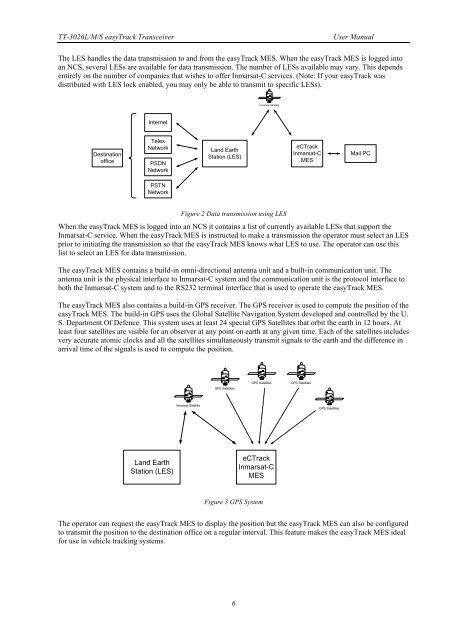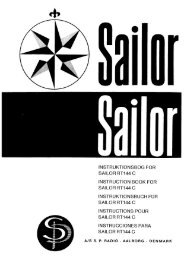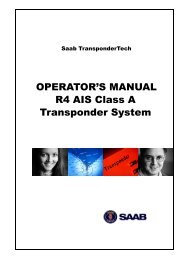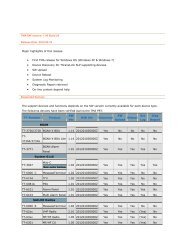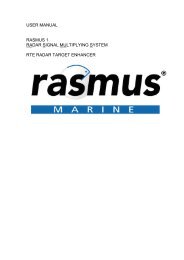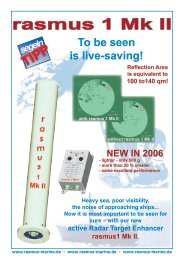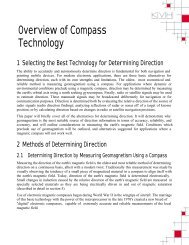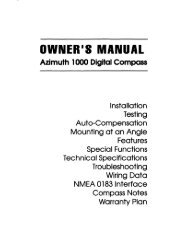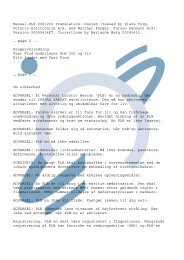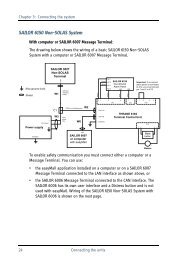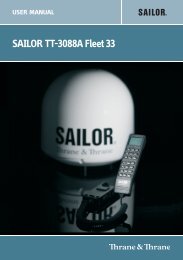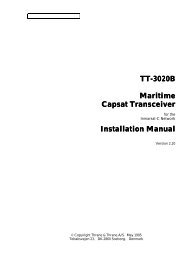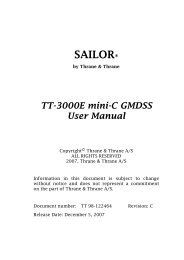Thrane & Thrane A/S TT-3026L/M/S easyTrack ... - Polaris-as.dk
Thrane & Thrane A/S TT-3026L/M/S easyTrack ... - Polaris-as.dk
Thrane & Thrane A/S TT-3026L/M/S easyTrack ... - Polaris-as.dk
You also want an ePaper? Increase the reach of your titles
YUMPU automatically turns print PDFs into web optimized ePapers that Google loves.
<strong>TT</strong>-<strong>3026L</strong>/M/S <strong>e<strong>as</strong>yTrack</strong> Transceiver User Manual<br />
The LES handles the data transmission to and from the <strong>e<strong>as</strong>yTrack</strong> MES. When the <strong>e<strong>as</strong>yTrack</strong> MES is logged into<br />
an NCS, several LESs are available for data transmission. The number of LESs available may vary. This depends<br />
entirely on the number of companies that wishes to offer Inmarsat-C services. (Note: If your <strong>e<strong>as</strong>yTrack</strong> w<strong>as</strong><br />
distributed with LES lock enabled, you may only be able to transmit to specific LESs).<br />
Destination<br />
office<br />
Internet<br />
Telex<br />
Network<br />
PSDN<br />
Network<br />
PSTN<br />
Network<br />
Land Earth<br />
Station (LES)<br />
6<br />
Inmarsat Satellite<br />
Figure 2 Data transmission using LES<br />
eCTrack<br />
Inmarsat-C<br />
MES<br />
Mail PC<br />
When the <strong>e<strong>as</strong>yTrack</strong> MES is logged into an NCS it contains a list of currently available LESs that support the<br />
Inmarsat-C service. When the <strong>e<strong>as</strong>yTrack</strong> MES is instructed to make a transmission the operator must select an LES<br />
prior to initiating the transmission so that the <strong>e<strong>as</strong>yTrack</strong> MES knows what LES to use. The operator can use this<br />
list to select an LES for data transmission.<br />
The <strong>e<strong>as</strong>yTrack</strong> MES contains a build-in omni-directional antenna unit and a built-in communication unit. The<br />
antenna unit is the physical interface to Inmarsat-C system and the communication unit is the protocol interface to<br />
both the Inmarsat-C system and to the RS232 terminal interface that is used to operate the <strong>e<strong>as</strong>yTrack</strong> MES.<br />
The <strong>e<strong>as</strong>yTrack</strong> MES also contains a build-in GPS receiver. The GPS receiver is used to compute the position of the<br />
<strong>e<strong>as</strong>yTrack</strong> MES. The build-in GPS uses the Global Satellite Navigation System developed and controlled by the U.<br />
S. Department Of Defence. This system uses at le<strong>as</strong>t 24 special GPS Satellites that orbit the earth in 12 hours. At<br />
le<strong>as</strong>t four satellites are visible for an observer at any point on earth at any given time. Each of the satellites includes<br />
very accurate atomic clocks and all the satellites simultaneously transmit signals to the earth and the difference in<br />
arrival time of the signals is used to compute the position.<br />
Land Earth<br />
Station (LES)<br />
Inmarsat Satellite<br />
GPS Satellites<br />
GPS Satellites GPS Satellites<br />
eCTrack<br />
Inmarsat-C<br />
MES<br />
Figure 3 GPS System<br />
GPS Satellites<br />
The operator can request the <strong>e<strong>as</strong>yTrack</strong> MES to display the position but the <strong>e<strong>as</strong>yTrack</strong> MES can also be configured<br />
to transmit the position to the destination office on a regular interval. This feature makes the <strong>e<strong>as</strong>yTrack</strong> MES ideal<br />
for use in vehicle tracking systems.


